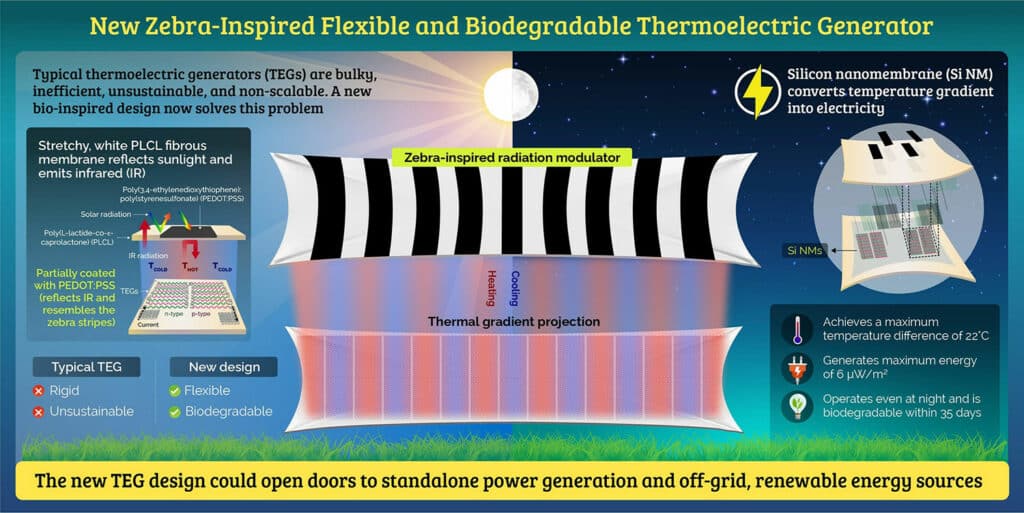Conventional thermoelectric generators (TEGs) are devices that convert heat to electricity. Such devices are extremely useful for generating electricity for remote sensors that cannot be connected to the main electricity grid. However, conventional TEGs are bulky and rigid as they require out-of-plane heating and cooling areas to create a temperature difference.
To tackle this, researchers at the Gwangju Institute of Science and Technology (GIST) in South Korea have now designed a new flexible, soft, and biodegradable TEG that gets its inspiration from an unlikely place – zebra skin. The novel design uses a pattern resembling black-and-white zebra stripes to create a high-temperature gradient below the surface that, in turn, can generate electricity.
“Traditional TEG designs are large and bulky as they rely on natural convection, which leads to an out-of-plane temperature gradient. This requires hard insulators, which limit the application of TEGs in flexible and wearable devices. We have now transcended this paradigm in our design by creating an in-plane device that is flexible and biodegradable. This increases its applicability while reducing its environmental impact by making it scalable, integrable, and sustainable,” explains the lead researcher Young Min Son.
The researchers used biodegradable poly(L-lactide-co-ε-caprolactone) (PLCL) material, which reflects sunlight and emits infrared radiation to keep the area below it cool, as white strips. The black poly(3,4-ethylene dioxythiophene): poly(styrene sulfonate) or (PEDOT: PSS), appearing black to the eye, provided the heat absorption required to create the temperature gradient underneath.

PEDOT: PSS absorbs the sunlight coming on it while reflecting the IR radiation coming from below it (emitted by the PLCL). This, in turn, increases the temperature of the area below the black stripes, creating alternating warm and cold regions, which can then be converted into electricity.
With the help of silicon nanomembranes in the design, the novel design was able to generate a maximum temperature difference of 22°C along with a maximum energy density of 6 μW/m². Additionally, the device was completely biodegraded in saline within 35 days.
The overall result suggests the new TEG design is sure to open doors to scalable, eco-friendly energy systems.
“The pandemic caused the widespread use of disposable masks and protective equipment, which pose a huge environmental impact. This underscores the need for sustainable and eco-friendly solutions like TEGs that can be incorporated in such wearable devices for performing specialized functions like self-power generation and sensing,” highlights Prof. Song. “Our design can fill in this gap thanks to its lightweight and biodegradable nature. It can also be integrated seamlessly into various energy and smart grid technologies to further enhance their functionality and impact.”
Journal reference:
- Won Bae Han, Se-Yeon Heo, Donghak Kim, Seung Min Yang, Gwan-Jin Ko, Gil Ju Lee, Dong-Je Kim, Kaveti Rajaram, Joong Hoon Lee, Jeong-Woong Shin, Tae-Min Jang, Sungkeun Han, Heeseok Kang, Jun Hyeon Lim, Do Hyeon Kim, Soo Hyun Kim, Young Min Song, Suk-Won Hwang. Zebra-inspired stretchable, biodegradable radiation modulator for all-day sustainable energy harvesters. Science Advances, 2023; DOI: 10.1126/sciadv.adf5883
